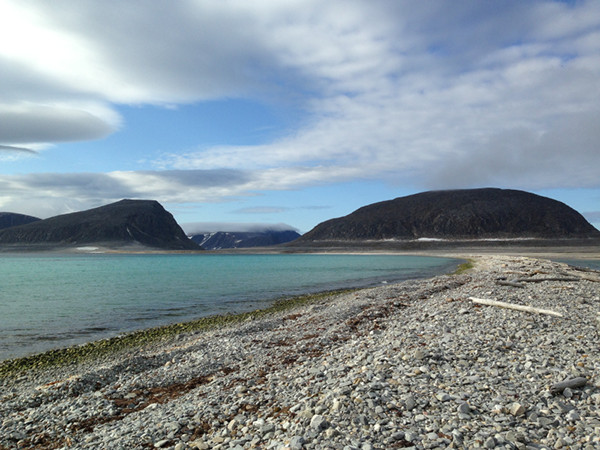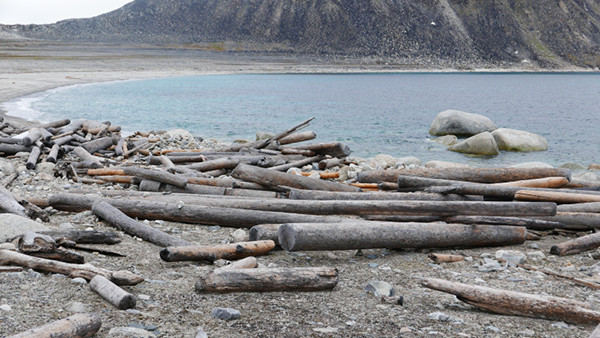
by Hannah Hagemann Thursday, December 28, 2017

Driftwood frozen into sea ice can be transported around the Arctic, eventually collecting on distant shores such as on the island of Phippsøya in Svalbard, which lies to the east of northern Greenland. Credit: Marc Macias-Fauria
Arctic driftwood up to 12,000 years old is giving scientists a better understanding of how ocean currents and sea ice in the far north have changed through the Holocene. In a new study, published in the Journal of Geophysical Research: Oceans, scientists at the University of Oxford in England studied more than 900 pieces of driftwood collected from Arctic shorelines since the 1950s to investigate how shifting Arctic Ocean currents help melt or fortify sea ice.
The trees from which the driftwood samples came grew in different parts of the Arctic throughout the Holocene, which began about 11,700 years ago. Picked up from the forest floor by wind or rain, tree branches and other pieces of wood can find their way into rivers that flow into the Arctic Ocean. The wood can then be incorporated into sea ice as it freezes and float — as passengers in the ice — along with ocean currents. When the ice melts, the wood is then washed ashore on Arctic beaches, where the lack of vegetation and seasonally limited sunlight slow its decay, making Arctic driftwood ideal for radiocarbon dating.
All of the specimens considered in the new study had previously been radiocarbon dated by other teams, but the Oxford researchers, geologists Georgia Hole and Marc Macias-Fauria, are the first to use the wood as a proxy for past sea-ice coverage and ocean currents. Using driftwood as a proxy can provide better resolution than ocean sediment cores, says Hole, lead author of the new study. “When you look at ocean cores, you are seeing resolution at 1,000 years. We can see changes in climate on a scale of 200 to 500 years.”
By studying differences in tree-ring patterns and the presence of fungi within the driftwood specimens, the team was able to identify wood from tree species from the genera Larix, Picea, and Pinus that are unique to parts of Canada, Eurasia and Siberia. Once the researchers knew where the driftwood came from, where it was found, and how old it was, they could identify the route the wood took through the ocean, which let them know how the prevailing currents flowed when each piece of driftwood was making its trip across the Arctic Ocean.

Researchers studied driftwood collected from around the Arctic since the 1950s to investigate how Arctic Ocean currents over the past 12,000 years have impacted sea ice. Credit: Georgia Hole
There are two large-scale, controlling currents in the Arctic: the Beaufort Gyre (BG), a counterclockwise current that is known to promote sea-ice preservation, and the Transpolar Drift (TPD), a current that exports sea ice and expedites melting. The TPD directs ice and its driftwood passengers from Siberia west, through the Fram Strait, to Greenland and Svalbard. The Beaufort Gyre, however, traps sea ice in the Arctic. When there’s a high concentration of sea ice in the Arctic, less melting occurs, and the wood is trapped, frozen within the ice. When sea-ice extent is low, more ice melts and, in turn, less ice blocks the coast, so the driftwood can float onto shorelines. Based on the ages of the driftwood, where the wood samples were collected, and how many samples were found during different periods of the Holocene, the team was able to deduce how sea-ice cover fluctuated throughout the 12,000 years studied.
The researchers found that during the early Holocene, from about 12,000 to 8,000 years ago, the BG dominated in the Arctic Ocean, and the sea-ice concentration was high while driftwood deposition was low. Temperatures rose from 8,000 to 4,000 years ago, and the extent of sea ice and shore-fast ice decreased as the TPD melted sea-ice and washed driftwood ashore. Then, 4,000 years ago temperatures cooled and the BG allowed the sea-ice extent to increase again. The two currents alternated dominating the Arctic on roughly 100-year timescales for most of the past 2,000 years, although recently the currents have alternated even more rapidly — on annual to decadal scales.
With warming temperatures, recent decades have also seen dramatic declines in Arctic sea ice: Ice volume has decreased 75 percent since the 1980s, and the annual maximum winter sea-ice extent last March was the lowest ever recorded in the Arctic, according to the National Snow and Ice Data Center. Bright-white sea ice regulates heat absorption in the Arctic by reflecting sunlight back into space. With less ice, there are more areas of dark open ocean to absorb heat and contribute to further warming.
The connections among increasing air and sea-surface temperatures, ocean current dominance and sea-ice preservation in the Arctic today, however, are not entirely clear. Josefino Comiso, emeritus scientist at NASA’s Cryospheric Sciences Laboratory who was part of the first global sea-ice mapping research project, says that although this study gives us insight into how ice cover has changed in the past, “it’s challenging to make conclusions in the present using proxy data, especially on issues that are so important.” Comiso says he wants to see more studies quantify Arctic sea-ice exports: “What volume of ice goes through the Fram Strait every year? So far, there’s no trend that is consistent with the decrease we’ve seen in sea-ice cover.”
But, identifying physical processes like the BG and the TPD, which have melted and fortified sea ice in the past, allows scientists to zero in on what physical and chemical processes are causing sea-ice loss today. “We know the Arctic is a controlling system for the overall [global] climate,” Hole says. “Seeing what sea-ice conditions were in the past, and how they changed is important. It gives us insight into how Arctic systems respond to temperature change.”
© 2008-2021. All rights reserved. Any copying, redistribution or retransmission of any of the contents of this service without the expressed written permission of the American Geosciences Institute is expressly prohibited. Click here for all copyright requests.